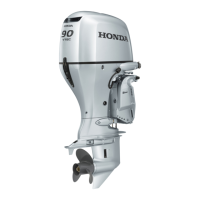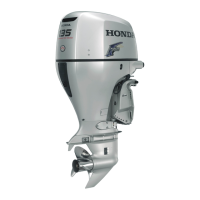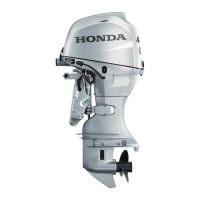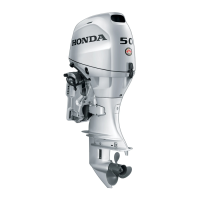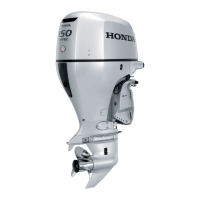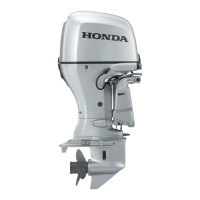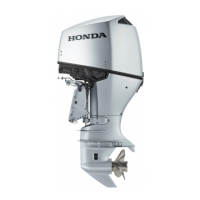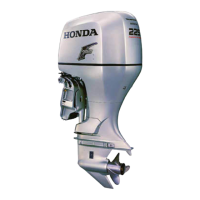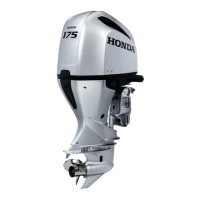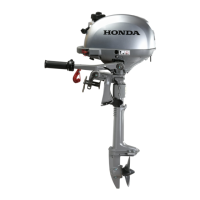Do you have a question about the HONDA marine BF60A and is the answer not in the manual?
Explains safety messages, symbols, and the importance of reading safety information.
General safety guidelines and precautions for using the outboard motor.
Details the operator's duties for safe operation and emergency preparedness.
Safety precautions and hazards associated with refueling the outboard motor.
Warns about the dangers of carbon monoxide from engine exhaust in enclosed areas.
Identifies the location of important safety labels on the outboard motor.
Explains model codes used to identify specific control and feature applications.
Diagrams illustrating the placement of all major components and controls on the motor.
Covers Ignition, Emergency Stop, Throttle Grip, Friction Adjusters, Gearshift, and Steering controls.
Details Ignition, Emergency Stop, Gearshift/Throttle, and Fast Idle controls for remote operation.
Explains the operation of Power Trim/Tilt and Power Tilt switches.
How to use the manual relief valve for tilting the outboard motor.
Adjusts engine speed in 50 RPM increments for trolling.
Supports the outboard motor in the fully-raised position.
Mechanism for fastening the engine cover securely.
How to adjust the trim tab to compensate for torque steer.
Explains Trim Meter, Tachometer, Rudder Meter, and Fuel Gauge functions.
Details ACG, Malfunction, Oil Pressure, Overheat, and Cooling System indicators.
Covers Overrev Limiter, Fuel Tank, Vent Knob, Priming Bulb, NMEA Coupler, Hour Notification.
Pre-operation safety checks and knowledge required for safe use.
Step-by-step checks to ensure the motor is in proper working condition.
Visual checks for leaks, damage, and proper connections before operation.
Checks for engine oil, propeller, anodes, and battery status.
Adjusts the tiller handle for optimal operator comfort and control.
Essential safety measures and practices for operating the outboard motor.
Instructions for the initial 10-hour break-in period for optimal performance.
Proper placement, securing, and capacity of the portable fuel tank.
Step-by-step guide for correctly connecting the fuel hose assembly.
How to use the priming bulb to ensure adequate fuel supply.
Recommendations for fuel storage and motor use for intermittent operation.
Covers starting procedures for tiller handle and remote control types.
Procedures for manually starting the engine if the electric starter fails.
Explains emergency and normal engine stopping procedures.
Details operation for tiller handle and remote control gearshift/throttle.
Explains steering for tiller handle and remote control, including friction adjustment.
Covers engine speed optimization for fuel economy and trim adjustments for stability.
Adjusting engine speed in 50 RPM increments for trolling.
How to adjust the trim tab to compensate for torque steer.
Precautions and techniques for operating in shallow water.
Procedures for docking, beaching, and launching the boat.
Operating and managing multiple outboard motors simultaneously.
Explains why proper maintenance is crucial for safe and economical operation.
Safety precautions to follow during all maintenance tasks.
Lists included tools and the owner's manual for basic repairs.
Information about the emergency starter rope and its availability.
Table detailing routine service intervals and recommended maintenance tasks.
Instructions on how to adjust the trim tab for steering correction.
How to use the manual relief valve for manual tilting.
Step-by-step guide for removing and reattaching the engine cover.
Procedure for checking the engine oil level with the dipstick.
Step-by-step guide for draining and refilling engine oil.
Recommended engine oil types, viscosity, and API service categories.
How to inspect, gap, and replace spark plugs for optimal engine performance.
Identifies lubrication points and intervals for motor components.
Instructions and precautions for safely refueling the outboard motor.
Guidelines on using the correct type and octane of gasoline.
How to inspect, clean, and service the fuel filter/water separator.
Steps for cleaning or replacing the fuel tank filter.
How to inspect and replace sacrificial anodes to prevent corrosion.
Procedures for removing and installing the propeller, including torque specs.
How to clean the exterior and flush the cooling system after use.
Detailed steps for flushing the cooling system using a garden hose.
Information on fuel deterioration during storage and recommendations.
How to add fuel stabilizer to extend fuel life during storage.
Procedures for draining the fuel tank and vapor separator.
Steps for preparing engine oil for long-term storage.
Instructions for safely hoisting the outboard motor for storage.
Recommendations for selecting a suitable storage area and protecting the motor.
Checks to perform when taking the outboard motor out of storage.
Guidelines for trailering a boat with the outboard motor attached.
How to securely transport the outboard motor when removed from the boat.
Troubleshooting steps for diagnosing and resolving starting issues.
Solutions for engines that are difficult to start or stall shortly after starting.
Diagnosing and resolving engine overheating issues, including indicator lights.
Information on fuse types, ratings, their functions, and replacement procedures.
What to do if the oil pressure indicator goes off and engine speed is limited.
Actions to take when the overheat indicator activates and engine speed is limited.
Interpreting the cooling system indicator and troubleshooting water flow problems.
Procedures for servicing a motor that has been submerged in water.
Where to find and record frame and engine serial numbers for reference.
Minimum battery requirements and essential safety precautions for connection.
Covers emission sources, PGM-FI system, regulations, and tampering warnings.
Explanation of the California Air Resources Board star labels for emission ratings.
Technical specifications for BF60A and BFP60A models.
Specific tune-up parameters like spark plug gap and idle speed.
Information on finding dealers, shop manuals, and parts catalogs.
How to contact Honda, resolve dealer issues, and overview of warranties.
Detailed terms, conditions, and exclusions of the limited warranty.
Warranty terms for marine accessories and replacement parts.
Specific warranty coverage for emission control system components.
California-specific warranty rights and obligations for emission controls.
Details on coverage terms and owner's obligations to maintain warranty.
How to obtain service, what's excluded, and liability disclaimers.
Warranty details specific to products purchased in Canada.
| Brand | HONDA marine |
|---|---|
| Model | BF60A |
| Category | Outboard Motor |
| Language | English |
